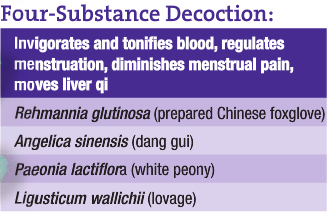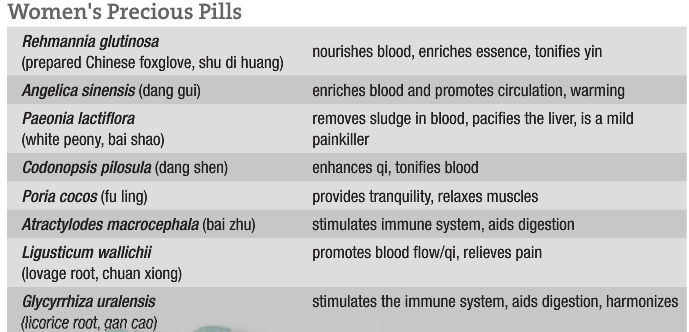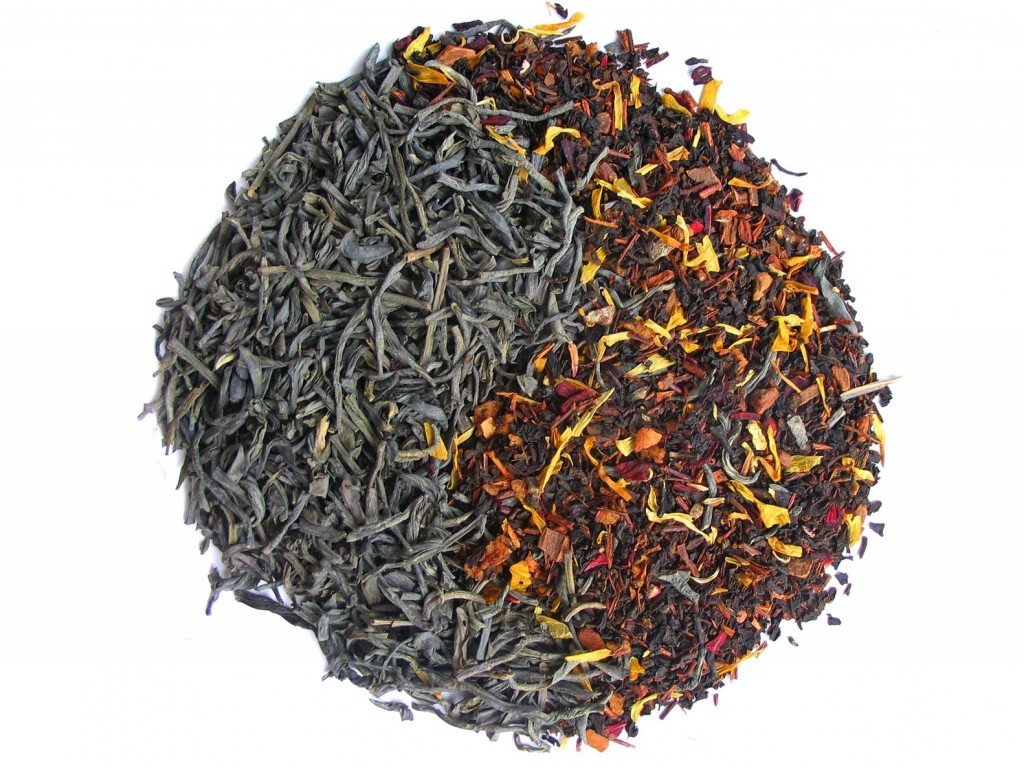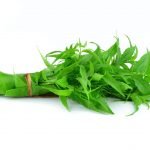Robin DiPasquale, ND, RH (AHG)
Qi is the commander of blood
Blood is the mother of qi
Qi moves blood and blood nourishes qi
The well-being of the female reproductive system can be differentiated and treated in Western medicine using the concept of hormonal balancing of estrogen, progesterone, and testosterone, keeping in mind the higher feedback centers of the hypothalamus and pituitary. Hormones can be measured through serum, saliva, and urine to help determine imbalances that reflect the symptoms being expressed.
A different insight can be gained, however, through the patterns of imbalance or pathology based on Traditional Chinese Medicine (TCM) diagnosis, often identifying more specifically how the imbalance is presenting and helping to determine which treatment options would be most beneficial. These patterns will most often fall into deficiency and/or stagnation patterns of qi and blood. Although there are numerous patterns to consider, this article will be an overview of the tonic herbs used in treating kidney yin deficiency and blood deficiency. Yin tonics and blood tonics can be given interchangeably. Yin tonics affect body fluids and provide moisture in conditions of dryness. They are often combined with other herbs to guide them to their target. They are sweet and cool in their nature. Blood tonics are yin in nature and can tonify many organ systems within the overall cycle.
Because of the role of the liver and its position in portal circulation, one cannot discuss reproductive organ function and menstrual disorders without including a correlation to some liver patterns. Alone or in combination with kidney yin deficiency and blood deficiency, the patterns of deficient liver blood, liver blood stasis, liver qi stagnation, and liver fire will contribute to symptoms of hormonal imbalance, menstrual irregularities, painful menstruation, and difficulty in perimenopause. Because it is linked with the liver, the emotion of anger will often be expressed in these patterns.
Because of the diminishment of moisture and cooling effects, kidney yin deficiency shows heat signs, including hot flashes, night sweats, thirst, burning soles and palms, and constipation. Heart palpitations can be present owing to the pattern of excess heart fire. Many of these yin deficiency symptoms are commonly seen in perimenopausal women but can be a part of the symptom picture for women of reproductive years with infertility, painful or irregular menses, and premenstrual syndrome (PMS) symptoms. Blood deficiency will manifest as signs of paleness, shortness of breath, and scanty menstrual flow. There can be a fair amount of symptom overlap between the 2 patterns of kidney yin deficiency and blood deficiency. These can include dry conditions (such as thirst, constipation, scanty menses, diminished mucous membrane secretions, and dry skin, hair, and mouth) and deficiency symptoms (such as dizziness, poor memory, ringing in the ears, hair falling out, fatigue, muscle weakness, low back pain, restlessness, anxiety, and insomnia).
In understanding the 5-element theory, meridians, and correlating organs in TCM, it is useful to recognize this flow. The heart controls blood, the liver stores blood, the spleen and the kidneys produce blood, and circulation-sex conducts the direction of blood. The entire cycle must be nourished, in motion, and in balance.
Royal jelly is an excellent food for building both kidney yin deficiency and blood deficiency. Other foods to consider for supporting the kidneys are kidney beans (doctrine of signature philosophy), black sesame seeds, walnuts, plums, berries, celery, parsley, and sea salt. Foods that build blood are beef, oysters, eggs, greens, red black dates, and other red berries. Both yin and blood deficiency patterns are nourished by asparagus, sweet potatoes, yams, squash, carrots, and grapes.
Western materia medica includes excellent herbs to consider when treating female reproductive health.1,2 These herbs, Vitex agnus-castus (chaste tree berry), Dioscorea villosa (wild yam), Chamaelirium luteum (false unicorn root), Rubus idaeus (red raspberry leaf), and Mitchella repens (partridge berry), to name a few, can also be prescribed based on various energetic patterns. In addition to describing which herbs increase progesterone or estrogen, Holmes3,4 in his book The Energetics of Western Herbs speaks of energetic patterns such as circulating uterus qi, harmonizing menstruation, tonifying reproductive qi, relieving blood congestion, and harmonizing blood. When any herbal treatment is applied with this awareness, the potential outcome in bringing effective change and balance is enhanced.
This discussion will focus on herbs from the TCM tradition, which can increase both your repertory to choose from and your understanding of the application of herbs to treat female reproductive imbalances through energetic patterns. As stated, herbs that are used to tonify the kidney yin and herbs that are used to tonify blood can be used interchangeably. Although this discussion will focus on herbs for these 2 energetic patterns primarily, keep in mind that the TCM formulas are designed to harmonize the workings of the entire body system, as the individual parts are only as strong as their harmonious blending with the whole.
Herbs to tonify yin include the following: Panax quinquefolius (American ginseng), Asparagus cochinchininsis and Asparagus racemosa (asparagus root), Polygonatum odoratum (Solomon seal [Polygonatum multiflorum is the European species and Polygonatum biflorum is the North American species, seemingly interchangeable]), Ligustrum lucidum (privet fruit), Sesamum indicum (black sesame seeds), and Ophiopogon japonicus (tuber of winter wheat).
Blood tonic herbs include Rehmannia glutinosa (both prepared and raw), Angelica sinensis (dang gui), Paeonia lactiflora (white peony), Polygonum multiflorum (black-haired Mr He), Lycium chinensis and Lycium barbarum (wolfberry), Mori alba (bud of the white mulberry), and Euphoria longan (longan fruit). Another blood tonic herb, Glycyrrhiza uralensis (or Glycyrrhiza glabra, used interchangeably), classified as a qi tonic, is often used in formula because of its harmonizing effects. Licorice is sweet, moistening, moving, and neutral in temperature and when used raw is useful in heat or cold conditions.
 Wisconsin is one of the leading states in the cultivation and production of P quinquefolius (American ginseng). Because of overharvesting and destruction of the hardwood tree habitat for ginseng in North America, sustainable cultivation of this valuable medicinal plant is necessary. This species of Panax is said to benefit qi, generate fluids, and nourish yin. It is an herb that supports the parasympathetic nervous system and acts as an adrenal tonic. It is cooling and nourishing, unlike its relative Panax ginseng, which can be too heating for yin-deficient states. Adrenal support and support of kidney yin go hand in hand. When the adrenal glands are able to harmoniously flow through their circadian rhythm, free of the burden of excessive stress response, they participate in the production and regulation of estrogen in a balanced way. In this time when estrogen dominance is a common pattern affecting women’s health, American ginseng can bring balance to symptoms of excess such as irritability, tension, and overactivity. Panax quinquefolius, an Araliaceae family plant, can assist in regulating and tonifying the output of cortisol, making it one of our top adaptogenic herbs.
Wisconsin is one of the leading states in the cultivation and production of P quinquefolius (American ginseng). Because of overharvesting and destruction of the hardwood tree habitat for ginseng in North America, sustainable cultivation of this valuable medicinal plant is necessary. This species of Panax is said to benefit qi, generate fluids, and nourish yin. It is an herb that supports the parasympathetic nervous system and acts as an adrenal tonic. It is cooling and nourishing, unlike its relative Panax ginseng, which can be too heating for yin-deficient states. Adrenal support and support of kidney yin go hand in hand. When the adrenal glands are able to harmoniously flow through their circadian rhythm, free of the burden of excessive stress response, they participate in the production and regulation of estrogen in a balanced way. In this time when estrogen dominance is a common pattern affecting women’s health, American ginseng can bring balance to symptoms of excess such as irritability, tension, and overactivity. Panax quinquefolius, an Araliaceae family plant, can assist in regulating and tonifying the output of cortisol, making it one of our top adaptogenic herbs.
In both TCM and Ayurvedic medicine, Asparagus spp, known as shativari in Ayurveda, bring increased moisture and cooling, a true yin tonic. The tuber of this Liliaceae family plant strengthens female hormones, promotes fertility, increases breast milk, promotes vaginal secretions, relieves menstrual tension and pain, and nourishes the entire female reproductive system.
Polygonatum odoratum, one of several species of Solomon seal, is another Liliaceae family plant that brings moisture and cooling. Traditionally, this plant has been applied to hot inflamed joints, decreasing inflammation and allowing relief of arthritic pain. Although not supported extensively in the literature for women’s health, this plant has significant yin tonic qualities that can be applied to hormonal balancing. Solomon seal has shown particular benefit for perimenopausal and menopausal women, who because of the diminishment of estrogen have decreased fluid in their joints and tighter ligaments, tendons, and connective tissue. Its lubricating ability allows for more graceful and fluid movement, with less pain and stiffness.
The Oleaceae family plant L lucidum (privet fruit) nourishes and tonifies the liver and kidneys. This sweet and bitter combination can assist in cooling excessive liver fire, which can manifest as irritability, anger, and an overall feeling of disgruntlement. Ligustrum enhances the immune system and has been shown to increase white blood cell count and prevent marrow loss associated with chemotherapy. Privet is used in liver tonification to address low back pain, graying of hair, knee and joint pain, and diminishing vision. Ligustrum lucidum is available for gemmotherapy, as a bulk herb, and in TCM formulas, often in combination with L chinensis (wolfberry) and M alba (bud of the white mulberry).
Sesamum indicum (black sesame seeds) is often referred to as the longevity herb. This Pedaliaceae family plant supports yin, builds essence and blood, and moistens the intestines. Sesame seeds, especially the black ones, are nutritive to yin, contain calcium that is easily assimilated, calm the nervous system, and are a good general tonic to ease the aging process, which is taking place for everyone every day. They bring moisture to the intestines, diminishing a tendency toward constipation. They are easily consumed as food, often ground and mixed with honey and ginger.
Ophiopogon japonicus, the Poaceae family tuber from winter wheat, is considered an overall yin tonic because it offers nourishment, provides moisture, and clears heat. Although not specific for kidney yin, its properties are supportive in formula with other herbs for kidney yin deficiency patterns.
The Scrophulareaceae family herb R glutinosa (Chinese foxglove) is the principal herb for nourishing kidney yin, as well as building blood and essence. Rehmannia is used in 2 forms, raw and prepared. Raw Rehmannia (sheng di huang) is sweet, bitter, and slightly cold; is more effective for clearing heat and cooling blood; and is used in deficient yin conditions with strong heat patterns. Prepared Rehmannia (shu di huang) is sweet and slightly warm and is applied more for tonifying blood and nourishing yin. Prepared Rehmannia draws qi downward and pulls scattered qi together, settling erratic qi that is uncontrolled by the kidneys and liver. Through nourishment, it helps reestablish balanced hormonal patterns, resolving irregular menses. As a blood tonic, it is given to build marrow and replenish lost blood from excessive menstrual bleeding and postpartum bleeding. Twelve iridoid glycosides have been isolated in Rehmannia, including catalpol, the prominent compound that stimulates the production of adrenal cortical hormones and reproductive hormones, and aucubin, a compound also found in V agnus-castus.5 Rehmannia is a key ingredient in TCM formulas for women’s reproductive health.
Angelica sinensis, in TCM called dang gui or tang kuei, is a warming and moving Apiaceae family plant. It invigorates blood, tonifies blood, nourishes the liver and heart, and moistens the intestines. Dang gui is used when liver qi or blood stagnation contributes to irregular menstrual cycles, PMS, or painful menses. This combination of actions harmonizes the flow of menstrual blood. When combined with Rehmannia, it reinforces blood-tonifying action. Women’s Precious Pills is a classic TCM formula that harmonizes the reproductive cycle, increasing energy, restoring vitality, tonifying blood, improving appetite, and diminishing PMS symptoms (see sidebar for formula).
The Ranunculaceae family herb P lactiflora is a blood and yin tonic. Paeonia nourishes and builds blood and balances deficient blood patterns. What distinguishes it among blood and yin tonics is that Paeonia acts to pacify the liver, soothing liver qi stagnation and clearing heat from the liver. This relaxes constrained qi, allowing for a more easeful flow of the cycle. Red peony is more effective at clearing heat from the liver, while white peony works more to pacify and quiet excess liver fire.
Paeonia is effectively combined with Bupleurum scorzoneraefolium (Chinese thoroughwax) to relax constrained liver qi, an energy that can bring up irritability during the premenstrual time. Peony is used to normalize ovarian function through hormonal balancing. In combination with Glycyrrhiza spp, it decreases prolactin levels, which can be elevated in an estrogen-dominant state. It also appears to act on the aromatase enzyme in various ways. When estrogen levels are low due to aromatase inhibition, peony reverses the effects. Peony seems to also support aromatase activity in the synthesis of estrogen from testosterone, reducing the production of androgens.
In TCM, Polygonum multiflorum, a Polygonaceae family plant, is referred to as black-haired Mr He because of its liver and kidney tonic action that prevents the hair from turning gray as one ages. This is an essence tonic and a blood tonic, used to build and strengthen the vital core, the kidney essence. It provides moisture, nourishment, and cooling energy. Although both are yin tonics, Polygonum multiflorum is not to be confused with the Liliaceae family plant Polygonatum multiflorum, another of the Solomon seal species.
Lycium chinensis (L barbarum) is the very popular little red berry that is known as wolfberry or goji berry. In traditional Chinese culture, Lycium berries were added to soups and stews as a nutritive blood and yin tonic. This Solanaceae family fruit is used for treating yin and blood deficiencies, a pattern seen in many female reproductive disorders, so it is only logical that it should be included in the formulas to rebuild in this way. Lycium can help with diminished libido and impotence, menstrual disorders, menopausal symptoms, musculoskeletal tightness and soreness, decreased vision, and skin conditions. It protects the liver, is an antioxidant, stimulates the immune function, builds blood, and increases reproductive secretions. Although it can make a good-tasting nutritious snack, Lycium should be cooked or soaked for easier digestion, as with all dried fruits.
 Mori alba, bud of the white mulberry, builds blood, nourishes yin, and moistens the intestines. Like Polygonum multiflorum, it can restore hair color in premature graying of the hair because of its liver- and kidney-tonifying properties. Mori can be combined with Rehmannia, both sheng di huang (raw) and shu di huang (prepared), to treat insomnia from deficient yin and blood. Especially during perimenopause, the experience of early morning waking with an inability to return to sleep is a kidney yin deficiency insomnia that will not generally respond to sleep herbs. Once kidney yin has been replenished, sleep will improve for these women.
Mori alba, bud of the white mulberry, builds blood, nourishes yin, and moistens the intestines. Like Polygonum multiflorum, it can restore hair color in premature graying of the hair because of its liver- and kidney-tonifying properties. Mori can be combined with Rehmannia, both sheng di huang (raw) and shu di huang (prepared), to treat insomnia from deficient yin and blood. Especially during perimenopause, the experience of early morning waking with an inability to return to sleep is a kidney yin deficiency insomnia that will not generally respond to sleep herbs. Once kidney yin has been replenished, sleep will improve for these women.
The fruit of the longan tree, with many names (Dimocarpus longan, E longan, and Nephelium longan), nourishes blood, tonifies the heart and spleen, and calms the spirit. These are all important tonifying actions when working with female reproductive health and balance, especially in calming the spirit. This is a tropical fruit in the Sapindaceae family (with seeds high in saponins) resembling lychee, sweet and warm. Longan is used with Ziziphus jujuba for deficient heart blood and deficient spleen qi, supporting circulation, digestion, and hormonal balance. For insomnia, longan is combined with Rehmannia, Mori, and lily bulbs. The Liliaceae family plants are very specific for support in women, providing moisture, coolness, and nourishment and bringing balance.
The study of energetic patterns and materia medica is extensive, whether it is applied to women’s health, the health of other physiological systems, or overall health, bringing a deeper understanding of the expression of each individual person. This calls us back to our naturopathic principle to treat the whole person. Learning about the energetic patterns in TCM or Ayurvedic medicine provides a more detailed view of what is behind symptoms and Western pathologic conditions, working with our naturopathic principle of tolle causam to identify and treat the cause. In expanding our knowledge and understanding of working with the principles of naturopathic medicine and with being fully present with our patients, the medicine we offer can bring about a more complete state of wellness and healing.
 Robin DiPasquale, ND, RH (AHG) earned her degree in naturopathic medicine from Bastyr University in 1995 where, following graduation she became a member of the didactic and clinical faculty. For the past eight years she has served at Bastyr as department chair of botanical medicine, teaching and administering to both the naturopathic program and the bachelor of science in herbal sciences program. Dr. DiPasquale is a clinical associate professor in the department of biobehavioral nursing and health systems at the University of Washington in the CAM certificate program. She loves plants, is published nationally and internationally, and teaches throughout the U.S. and in Italy on plant medicine. She is an anusara-influenced yoga instructor, teaching the flow of yoga from the heart. She currently has a general naturopathic medical practice in Madison, Wis., and is working with the University of Wisconsin Integrative Medicine Clinic as an ND con-sultant.
Robin DiPasquale, ND, RH (AHG) earned her degree in naturopathic medicine from Bastyr University in 1995 where, following graduation she became a member of the didactic and clinical faculty. For the past eight years she has served at Bastyr as department chair of botanical medicine, teaching and administering to both the naturopathic program and the bachelor of science in herbal sciences program. Dr. DiPasquale is a clinical associate professor in the department of biobehavioral nursing and health systems at the University of Washington in the CAM certificate program. She loves plants, is published nationally and internationally, and teaches throughout the U.S. and in Italy on plant medicine. She is an anusara-influenced yoga instructor, teaching the flow of yoga from the heart. She currently has a general naturopathic medical practice in Madison, Wis., and is working with the University of Wisconsin Integrative Medicine Clinic as an ND con-sultant.
- Bensky D. Chinese Herbal Medicine Materia Medica. Seattle, WA: Eastland Press; 1986.
- Bensky D. Chinese Herbal Medicine Formulas & Strategies. Seattle, WA: Eastland Press; 1990.
- Holmes P. The Energetics of Western Herbs. Vol 1 and 2. Boulder, CO: Snow Lotus Press; 1994.
- Holmes P. Jade Remedies: A Chinese Herbal Reference for the West. Vol 1 and 2. Boulder, CO: Snow Lotus Press; 1996.
- Chang HM, But PPH, eds. Pharmacology and Applications of Chinese Materia Medica. Singapore: World Scientific; 1986.





